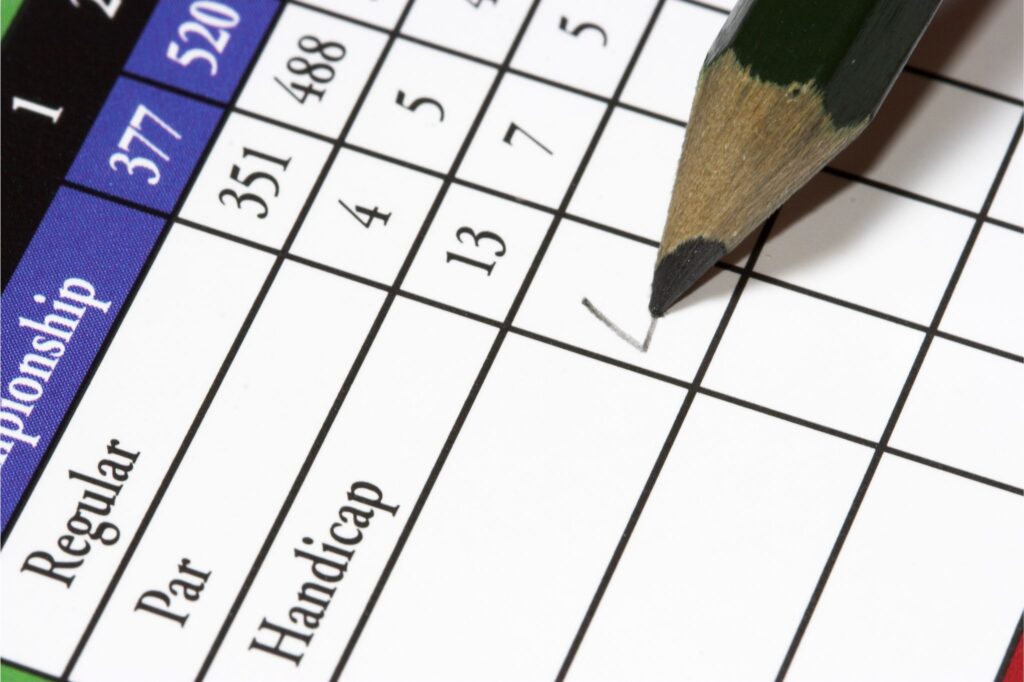Do you want to lower your golf handicap and up your golfing game this season, but your skill set doesn’t cooperate with your goal? No worries, this blog is here to end your stress. We will discuss handicap golf strategy so you can easily lower golf handicap by 3 strokes and earn the title of a pro golfer. But also keep in mind that you need to stay consistent with your gaming skills, or else you will never be able to achieve the specific milestone. You might ask yourself how the Golf Handicap is calculate? The USGA can shed some light on that.
Table of Contents
Polish Your Golf Short Game
The quickest way to cut strokes from your golf game is to master your short game; the shots you take around the green and your putting account for a large percentage of your total score. Therefore, do the following: Putt with Purpose!
If you want to see your name in the list of golfers who have a lower golf handicap, then you need to take out a minimum of 15-20 minutes, twice or thrice a week, for putting. Pay close attention to the gate drill, which is going to be two tees slightly wider than your putter head, a few feet from the hole, to roll the ball cleanly. The ladder drill, where hitting putts of increasing lengths– 3,6,9 feet- and trying to hole them, and single-handed putting to improve your control and feel.
Green Reading in Golf
Pay attention to the slope going up to the hole, and the grain of the grass. Read the subtle breaks. Explore your point to get an idea regarding different perspectives. As part of golf improvement tips, we suggest that a good routine consists of identifying the high point of the break and imagining the ball flawlessly rolling into the hole.
Fitting your Putter in Golf
A lag put is important for avoiding three-putts. Start practicing hitting putts from a longer distance, such as 20-30 feet, and focus on getting the ball within a comfortable two-putt range. Focus on the hole and imagine that it is encircled; try to finish inside it. Make sure your putter is fit according to the correct lie angle, length, and loft for your stroke and stance, or else a poorly fitted one can impact your training
Golf Fun Fact!
Did you know?
The longest recorded golf putt was an incredible 375 feet.


Wedges are Your Weapons in Golf
Championing Different Distances. Don’t aim to hit the ball anywhere on the green with your wedges; instead, hit shots to particular distances like 30, 50, 70, 90 yards, etc, with a variety of swing lengths and multiple clubs. You should know you carry distances with each wedge.
Strategic Course Management
Risk-Reward Assessment. Analyze the risk versus the reward of going for the shot. Especially, if it is on par-5s or trying to cut corners. In this case, a comfortable wedge distance is the smarter play.
Focus on Fundamentals. Your swing demands that you focus on the basic principles, such as a tight grip, posture, stance, and alignment. One tiny mistake and it is going to cost your entire game. If you think you can’t ace the game on your own, then get in touch with a qualified instructor to identify your mistakes and correct them accordingly.
Select The Target. Make your goal to hit at the widest part of the fairway off the tee, especially on tighter holes. When going towards the green, aim for the fat part, especially if the pin is tucked. While training yourself to lower golf handicap, it isn’t always about hitting the ball ahead, but about making witty decisions on the course
Wind and Elevation. See the direction and strength of the wind, plus changes in the height. These factors play a vital role in opting for selecting the club and shot route. You need to adjust your club and aim based on that.
Bunker Play Confidence. Sand won’t spoil your game, rather, it allows you to use your bunker technique. Here, focus on opening the clubface, taking sand with the ball, and maintaining a smooth swing.
Chip shots; practice hitting different kinds of chip shots in the form of the bump and run, the higher, the lofted flop shot, and the standard chip. Don’t casually use any; understand when to use each based on the lie, any other obstacles, and how far the distance to the pin is. Keep hitting until your ball hits the right spot.
Solidify Your Full Swing. Lastly, you must solidify your swing, meaning you have to focus on remaining consistent and accurate, as these carry more marks to lower golf handicap:
Know Your Limitations. Be honest about your weaknesses and strengths. Avoid bragging about your skills that might have a low probability of success. Know your limitations, otherwise you might face mockery.
Learn From Your Mistakes in Golf
It will take time to lower golf handicap, therefore, handicap golf strategy says that after each round, analyze your mistakes. Was your club selection wrong, or did you fail to access the putt? Get a scorecard and note down your shots.
Tempo and Rhythm. Don’t get aggressive with your club, assuming that you will hit the ball with full power and win the game. No, many times, a smoother and a controlled swing makes you the person of the tournament. Therefore, focus on a consistent tempo throughout your swing.
Weight Transfer and Balance. Maintaining your balance is critical, and you need to practice it throughout your swing. Besides, make sure the weight is also properly transferred from your back foot to your front foot, targeted towards the downswing.
Controlled Practice. When you proceed with practicing on the driving range, don’t randomly hit balls. Focus on particular targets and replicate your on-course swing. Hone your skills by using different clubs and shot shapes, and adjust pre-shot routines into your practice.
Record Video. While playing, put your mobile on the side or ask your trainer to record a video. That will help you in identifying areas for improvement. Watch how your fellow golfers hit the ball and compare your swing to achieve your lower golf handicap.
Conclusion & FAQ’s
We hope you understood the handicap golf strategy for getting the desired lower golf handicap. However, if you are still interested in more about this aspect, then check out Golf Inquirer. The compact Journal offering everything related to golf.
What are the most effective practice strategies for lowering my handicap?
To effectively lower your handicap, your practice should be deliberate and focused. Instead of just hitting balls, dedicate specific time to each aspect of your game. For example, spend 30% of your practice on putting (especially within 10 feet), 30% on chipping and pitching (from various lies and distances), 20% on iron play (focusing on consistent striking and target accuracy), and 20% on driving (prioritizing accuracy over pure distance). Incorporate drills that simulate on-course scenarios, such as playing “up and down” from different greenside locations or aiming for specific landing zones with your drives.
How important is course management in improving my handicap, and what are some key principles?
Course management is incredibly important and often overlooked. It’s about making smart decisions that minimize risk and maximize your chances of a good score, even when your swing isn’t perfect.
Should I invest in new equipment, or is my current gear sufficient for handicap improvement?
While new equipment can sometimes offer marginal gains, it’s generally not the primary driver of handicap improvement, especially for mid to high handicappers. Focus on improving your technique and course management first. However, if your clubs are very old, ill-fitted, or significantly damaged, a professional club fitting could be beneficial.
What role does physical fitness play in lowering a golf handicap, and what kind of exercises are beneficial?
Physical fitness plays a significant role in both performance and injury prevention, which indirectly helps your handicap. A stronger, more flexible body can lead to a more repeatable and powerful swing.



